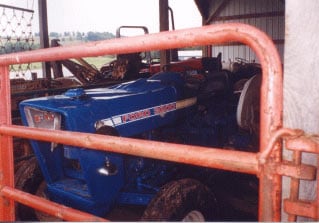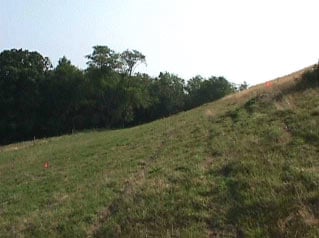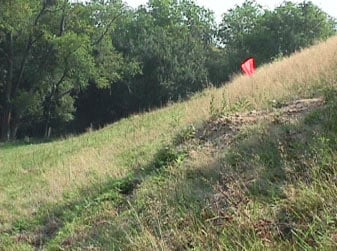Part-time Farmer Dies Following a Tractor Rollover in West Virginia
Case: 02WV024-01
Release Date: December 19, 2002
SUMMARY
On July 23, 2002, a 74-year-old male part-time farmer (victim) died of injuries sustained when the tractor he was driving rolled over while mowing a hillside. The tractor was equipped with a side mount sickle-bar cutting attachment. With his left rear wheel on the downhill side, he was traversing a slope exceeding a 50% grade (27 degrees). Speed of travel was unknown but his right wheels ran over a woodchuck mound which increased the grade to approximately 60% (31 degrees). This shift placed the tractor’s center of gravity (C.G.) outside of the tractor’s stability baseline, causing it to roll downhill to the left and land on the victim. The tractor did not have a rollover protective structure (ROPS) or a seat belt. The victim’s son-in-law came out to the field to check on the victim and found him lying on the ground shortly after being struck-by the tractor. He called EMS which arrived within minutes and transported the victim to a medical center were he died approximately 3 hours later. The cause of death was listed as traumatic arrest as a result of thoracic aortic disruption. The WV FACE investigator concluded that to reduce the likelihood of similar occurrences, the following guidelines should be observed by tractor owners:
- Equip all tractors with rollover protective structures and a seat belt.
- Consider permanently omitting steep areas from mowing.
INTRODUCTION
On July 25, 2002, the WV FACE Program was notified via a newspaper clipping that a tractor-related death had occurred on July 23, 2002. The field investigator traveled to the area on August 14, 2002 and met with the state police to discuss the incident. Photographs and measurements were taken of the incident site. The trooper who investigated the incident was interviewed as well as the victim’s grandson who was also the deputy sheriff. The death certificate, medical examiner’s report, state police report, and photographs were obtained.
The victim was a bus driver for the local school system and a part-time farmer. He was an experienced tractor operator with nearly 60 years of experience. He had owned, operated, and maintained the tractor involved in the incident for 6 months. The tractor, as purchased, did not have a ROPS or a seat belt.
Just prior to the incident, the victim was mowing the flat areas near the barn and house. The victim’s son-in-law was mowing the steep bank with another tractor and decided to stop when he felt it was getting too steep. The son-in-law drove down to the flat area at which time the victim decided to take over mowing the steep bank. The bank was not regularly mowed due to its steep nature. Although the victim had used the same tractor for the past 6 months, it was reported that the tractor had never been used on this particular bank.
INVESTIGATION
On July 23, 2002, a 74-year-old male part-time farmer (victim) died of injuries sustained when the tractor he was driving rolled over while mowing. The victim was using a 1965 Ford 3000 wide front-end configured tractor (see Figure 1). The tractor was equipped with a side mount sickle-bar cutting attachment. With his left rear wheel on the downhill side, he was traversing a slope exceeding a 50% grade (27 degrees) (see Figure 2). Speed of travel was unknown but his right wheels ran over a woodchuck mound which increased the grade to approximately 60% (31 degrees) (see Figure 3). This shift placed the tractor’s C.G. outside of the tractor’s stability baseline, causing it to roll downhill to the left and land on the victim. The tractor did not have a ROPS or a seat belt. The victim’s son-in-law came out to the field to check on the victim and found him lying on the ground shortly after being struck-by the tractor. He called EMS which arrived within minutes and transported the victim to a medical center were he died approximately 3 hours later.
CAUSE OF DEATH
The cause of death was listed as traumatic arrest as a result of thoracic aortic disruption.
RECOMMENDATIONS/DISCUSSION
Recommendation #1: Equip all tractors with rollover protective structures and a seat belt.
[ Owners of older model tractors should contact their County Extension Agent, equipment dealer or equipment manufacturer to determine if retrofit ROPS and operator restraint systems are available for their equipment. Such systems should be installed by the manufacturer or an authorized dealer ].
Discussion: Preventing death and serious injury to tractor operators during rollovers requires the use of ROPS and a seat belt. These structures, either a roll-bar frame or an enclosed roll-protective cab, are designed to withstand the dynamic forces during a rollover. In addition, seat belt use is necessary to ensure that the operator remains within the “zone of protection” provided by the ROPS. OSHA regulations require that all tractors built after October 25, 1976, and used by employees of a farm which employs 11 or more must be equipped with ROPS and a seat belt.1 In West Virginia, many tractors are in use on family farms with fewer than 11 employees and therefore do not fall under OSHA regulations. Given the uneven terrain and environmental conditions in West Virginia, all farmers should voluntarily have their older tractors retrofit with a properly designed ROPS and seat belt system. A ROPS retrofit kit is available for the tractor involved in this incident (1965 Ford 3000). If the tractor had been equipped with a ROPS and seat belt had been used, this fatality might have been prevented.
Recommendation #2: Consider permanently omitting steep areas from mowing.
Discussion: Discussion: Steepness of slope and the traversing of hillsides are variables associated with tractor rollovers in West Virginia. Rate of speed, operation being performed, smoothness of terrain, tractor model, wheel configuration, attachments, and the operator’s actions also play a role. Therefore, assigning a specific numeric figure as a “do not exceed” degrees of slope is difficult. However, a slope exceeding a 50% grade, as was the case in this incident, leaves little room for operator error and uneven terrain and should be avoided. In fact farmers who have slopes in this range should carefully consider whether mowing them is crucial to the farm’s operation. Those slopes which are not critical to the operation and productivity of the farm should be allowed to naturally return to brush and eventually woods. Where mowing is necessary, other safer means such as walk behind mowers should be used. Another possibility may be the integration of vegetation eating livestock such as goats.
REFERENCES:
- Office of the Federal Register: Code of Federal Regulations, Labor, 29 CFR Part 1928.51 (b), U.S. Department of Labor, Occupational Safety and Health Administration, Washington, D.C., April 25, 1975.
ILLUSTRATIONS

Figure l. 1965 Ford 3000.

Figure 2. The 50% (27 degree) slope the tractor was traversing. From this perspective, the tractor was traveling away from you.
The black arrow represents the tractor’s position before the roll.

Figure 3. The orange flag marks the dirt mound which was created by a woodchuck.
The tractor’s right front and right rear wheels ran over this mound causing the tractor to roll left down the slope.
FATALITY ASSESSMENT AND CONTROL EVALUATION PROGRAM
The WVU Center for Rural Emergency Medicine, through a contract with the West Virginia Department of Health and Human Resources and Bureau for Public Health, conducts investigations on the causes of work-related fatalities within the state. The goal of this program is to prevent future fatal workplace injuries. West Virginia FACE intends to achieve this goal by identifying and studying the risk factors that contribute to workplace fatalities, by recommending intervention strategies, and by disseminating prevention information to employers, employees, trade associations, unions, equipment manufacturers, students, teachers, and others with an interest in workplace safety.
Please use information listed on the Contact Sheet on the NIOSH FACE website to contact In-house FACE program personnel regarding In-house FACE reports and to gain assistance when State-FACE program personnel cannot be reached.
